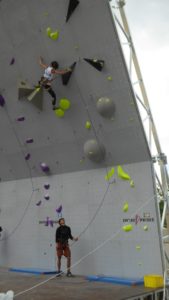HowNOT2 Videos – Climbing Safety
In scuba diving and aviation safety is a discussion that takes place before and after every dive or flight. It is discussed every time divers meet up. With climbing safety is important too but the focus is different. “This is how you should belay, this is how you should climb, this is how you should set up the top rope, and more.
With climbing I know what the safety rules are but I don’t necessarily know what the numbers mean. As an example, it’s because I read construction instructions for how to setup a Via Ferrata that I learned how safe they are.
It’s because I went with a VF maintenance crew that I learned about the safety steps to ensure that a VF is safe before the season begins.
I came across on Youtube and watched a few interesting videos yesterday. These videos have value because they test equipment, as it’s meant to work, and then when people make mistakes. It shows how different the performance on safety gear is.
In one video they show safety gear that is over a decade old. He mentions that it’s rated to 20km but when it is tested it lasts to just 13kn or so. The effect of age on that sling is clear.
A few years ago I belayed at an IFSC World Championship so I practised falling, and belaying. I learned how to catch a fall dynamically, rather than violently. Violently might not be the right term. The point is I learned to assist a fall, rather than give a hard stop.
Via Ferrata Safety
In climbing part of the fun is to push, and fall, but in Via ferrata the opposite is true. In VF you’re meant to stay within your comfort zone, and use a sling to rest. You’re not meant to fall. . When you do Via Ferratas the sling is there in case of emergency, to stop you from falling to your death. If you fall in VF you will fall to the next “queue de cochon”, pig tail in English. Your shock absorber will then deploy and you will smash against the cliff.
Falling Versus Safety
In climbing falling is part of the sport, so if you get used to falling without fear then you can push further. You can make progress with your climbing style and go up to more challenging grades.
With VF the kit is there in case you slip and fall. It will keep you in situ but you may be stuck. That’s why it’s good to be with others, but also why it’s good to know your limits.
In VF I have seen people get stuck two or three times. In both cases we needed to use ropes to get the person back onto the VF in one case, and beyond a challenging bit on a second VF.
And Finally
My reason for watching such videos is to get a better understanding of how safe what I am doing is, but also how dangerous mistakes can be. If you understand the risks you’re more likely to do things the right way.
It’s like the zip line I could have done a few days ago. I had everything I needed, but I haven’t done it for so long that I had to remember how to do it safely. You put the tandem speed on the cable. You attach your sling to the tandem speed and then you add the via ferrata set behind the tandem speed. You hold the top of the tandem speed, check that everything is in order and then . It’s a lot of fun, once you overcome your fear. In some places you can do them more than once. You can repeat the fun part. It also allows people to share their equipment.
When climbing and doing dangerous sports either get someone you trust to show you how to be safe or get a professional guide to guide you the first time.
My first VF was with a guide. So were my first climbs. It’s only when I understood the principles that I went with groups of enthusiasts.




